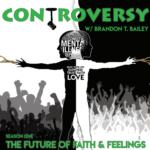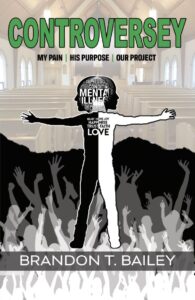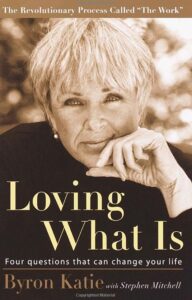It’s Okay if You’re Not Okay…
But It’s Not Okay to Stay That Way

Why is Mental Health a Controversial Topic?
I have to be honest… I grew up in a time and place when you simply didn’t talk about mental health. I didn’t talk about my feelings and I didn’t know many others that did. The question is why. Why is mental health such a taboo or off-limits subject in most households? Why aren’t communities more educated about the various types of mental health disorders and the symptoms that accompany them? People fear what they do not understand, and therefore, one of the goals of the Controversy Project is to educate communities on the topic and decrease the fear surrounding mental health stigmas. Open dialogue about these matters allows for the erosion of confusion and stereotypes and gives way to the building of solutions towards living healthier and more purposeful lives.
My Perspective as an Educator
I began my journey as an educator by mistake. I was the college student that said I would never work in schools. I had other plans for my career. Nevertheless, I stumbled into a school teaching after school music programs on the southside of Chicago. The passion for education that came from this experience led me to the journey I now tread. I have been a Paraprofessional, an ESS teacher, a music teacher and now an administrator. I have taught elementary and secondary and I have worked in higher education. I have worked in many departments and served a diverse group of students. I have never seen a need quite like this one.
I moved into school administration because I saw it as the place I could have the greatest impact. It was the one way I could use all the skills and experiences acquired along my journey.

The Effects of Trauma
Adverse Childhood Experiences (ACEs) – ACEs are potentially traumatic events that occur in the lives of children between the ages 0 and 17. According to the National Child Traumatic Stress Network (2016), children impacted by trauma can display difficulties with social skills, aggression, trust, dysregulation, fearfulness, anxiety and a host of avoidant behaviors (Honsinger & Brown, 2019). Between 55 and 90 percent of people living in the United States have experienced at least one traumatic event (Fallot & Harris, 2009).
Modern data shows that the higher the number of ACEs a person experiences, the greater the chances they will experience severe health problems in adulthood (Terrasi & de Galarce, 2017). Trauma is also insidious and people who are poor, homeless, suffer from mental health or addiction, have developmental disabilities or other disadvantages are at increased risk of suffering. One of the things I found to be incredibly interesting in my research was that institutions, like schools and churches, are places where trauma (especially violent trauma) is perpetuated instead of eliminated or mitigated (Fallot & Harris, 2009). Where and how do people find relief?
Physical health is only one area that can be challenged by chronic exposure to trauma. According to psychologist and trauma expert, Peter Levine, often after a traumatic situation, that action energy becomes stuck in your body because it was not released or used. When the energy doesn’t get released, it stays stuck and causes a range of symptoms. Levine added that in addition to “classic” trauma symptoms such as flashbacks and nightmares, you may experience chronic pain or chronic stiffness, among other physical symptoms.You might be familiar with the body’s fight, flight or freeze responses to trauma, but you’re also equipped with two others — the submit and attach survival defenses — when those first three options haven’t gotten you out of danger.
Trauma-Informed Educational Practices
My doctoral research was on Trauma-Informed Music Education: A New Perspective on Care in K-12 Music Education. It was inspired by my interest in trauma-informed educational practices and my role as a music educator at the time. Completing this study was definitely the activity that reflects my philosophy as an educator. I am deeply interested in school culture and the impact of trauma on the learning environment. That interest led me to a research study that guides my work as an administrator today. I am deeply focused on intentionally creating safe learning environments that are trauma-informed and inspire growth in both students and teachers. The study ended and my degree was conferred but the work of culture changing has just begun.
The trauma-informed approach in education begins with a realization that trauma in children is pervasive and not confined to students with emotional and behavioral disabilities or select schools and communities (Honsinger & Brown, 2019). Educators are therefore called to move beyond their subject matter expertise and explore the realms of proficiency in relationships with students (Watts et al., 2020). The awareness of this necessity is a foundational component of teaching and learning that content specific discussions often overlook. This is the work of TRAUMA-INFORMED educators.
The Fallot and Harris research established foundational principles for establishing a trauma-informed classroom environment. The trauma-informed principles are ensuring safety, establishing trustworthiness, maximizing choice, maximizing collaboration, and prioritizing empowerment. Each of these principles provide a guide for educators to evaluate their teaching philosophy, classroom environment, curriculum and overall approach to teaching through the lens of Trauma-Informed Care. These principles are relevant to this project because they extend beyond the hallowed halls of our schools. They are relevant in our workplaces, social environments, and places of worship. I will make these concepts easy to understand and access across multiple modalities.

The Controversy Project
I have always wanted to make a difference in the lives of others. This is why ministry was such a great outlet for me. Unfortunately, I developed the unrealistic expectation that I had to maintain a spotless image in order to be effective. This developed a strong fear of sharing any struggle or shortcoming. As trauma emerged in my life so did the fear to let these struggles be seen. In 2014 I lost my dad. This put me on a journey down a dark path of depression, fear and self-doubt. This fear paralyzed my progress and kept me from sharing even the good things that were going on in my life. The Controversy Project is an artistic snapshot of my healing journey.
My Pain
I grew up in church my entire life. I have ministered in front of thousands of people and encouraged them to trust in the Lord. Nothing prepared me for my faith to falter. I have been an educator, a performer, an entrepreneur and a writer. I experienced success and incredible setbacks but my faith had never waivered. Insert 2014. In late 2014, I faced financial hardship, a miscarriage and the death of my father. When my father died, my sense of purpose died with him. My ministry felt empty, my confidence was failing and my foundation was breaking. I was standing on stage every Sunday, singing the praises of the Lord while depression was slowly taking over me. As life’s difficulties continued to arrive, for the first time my faith began to shake. Although I have been “taking it to the Lord in prayer” for my entire life, I had no idea what to do. I was struggling in my career, in my relationships, and my mental/emotional health. I couldn’t believe that this could happen to me. I started folding under the pressure of depression despite all of the tools in my toolbox failing.
His Purpose
At the intersection of dealing with the death of my father and attending a PD about the adverse effects of trauma is a man wrestling with his mental health and his faith. The tension I experienced gave birth to an inquiry about mindfulness, mental health, faith, education and how they all impact each other. From the ashes of the pain emerged the phoenix of a new purpose. I used to see purpose as the place where I found success. If I was not successful then I was not operating in my purpose. When my pain became a focal point, my purpose suffered. It was a long journey back to peace and purpose. I learned and grew a lot. I now seek to expand your perspective about my journey and yours. If I can help somebody learn to live on purpose in spite of any hardships and struggles that may come their way, then I will be living his purpose.
Our Project
Controversy is a disagreement, typically when prolonged, public, and heated. This project acknowledges that we all go through trials and tribulations. It is how we deal with them that truly demonstrates our character. This is what the project is truly about. It is a documentary reflection of the journey to healing and the return to purpose. It is an expression of real emotions and true inspiration shared in a controversial collection of multimedia art. It is for the sinner, the hurting, the neglected, the forgotten. It is for those that want to give up but are doing their best to “keep” their faith.
The vision of the project is to promote holistic health with an emphasis on mental and emotional stability for survivors of trauma. Controversy is about using music and entertainment to spark difficult conversations about dealing with trauma and developing the skills to use it to live their purpose. The following products are conversation starters. They are the tip of the iceberg. Controversy is our project because we all need to step up our efforts to combat the impact of trauma on the mental health of our society. This project seeks to start a larger conversation about the response to child-trauma in schools and churches and how our society is affected by it.

Controversy Podcast
The Future of Faith and Feelings
In 2019, I launched Season 1 of the Controversy Podcast. Season 1 of the podcast is a multimedia conversation about faith and feelings. The show is hosted by me, Dr. Brandon T. Bailey. It contains honest conversations about the tension between faith & mental health along with interviews with mental health professionals, pastors, people of faith, educators & regular people trying to answer the question, “What is the future of faith & feelings?” The 24 episode podcast season contains a topical conversation and an engaging interview with influential voices. The podcast was written for the trauma survivors and trauma supporters exploring the tension between faith and feelings.

Controversy EP
My Pain / His Purpose
The Controversy EP was the initial concept for the entire project. The EP was a music therapy project that I decided to share with each of you. This project does not fit into any traditional box. It contains various genres, styles, and approaches at the same time. It contains both explicit language and scripture. It is deeply personal and vaguely commercial. Gospel music is about uplifting the spirit and the soul. It is about turning your heart towards God. Blues is about heartbreak and struggle. Both Rock & Roll and R&B Soul are about feelings, relationships, and simply put… life. The Controversy EP is what you get when you have an artist that isn’t trying to fit into a neat label.
The Controversy EP is designed to be digested as both a unique expressive piece of art and an eclectic collection of individual statements. The project contains singles in multiple genres and content In all forms, (music, literature, multimedia productions and stage productions). If you listen to the entire project then you get a musical picture of the entire pain to purpose journey. If you find your favorite single then you can appreciate an interpretation of classic songs that had a major impact on my healing journey. This EP is what you get when life doesn’t go the way you planned it. It is the real reaction to life’s ups and downs for both believers and non-believers. It is intended to spark difficult conversations regardless of your religious affiliation. Controversy is about making a change for the better.

The Controversy Book
My Pain, His Purpose, Our Project
The Controversy Book is a collection of meaningful stories inspired by the Controversy EP and the overall vision for the Controversy Project. Each song chosen for the EP had a meaningful connection to my journey from pain to purpose. Each song has a story. Each story provided inspiration, motivation or simple perspective as I sorted through difficult life questions. What does faith in crisis look like? What does trauma feel like? What are the effects of suffering in silence? What does the healing process look like when faith is failing? “My soul looks back and wonders how I got over.”
The Controversy Book shares stories about my pain and the trauma-induced mental health challenges that shook my foundation. The book shares my exploration of purpose and how reconnecting to my faith helped to establish my sense of purpose in life. The book shares stories that paint a picture of a life where mental health is less taboo and crucial conversations about controversial topics are the norm. Underneath each individual story in the book is a process of recovery and healing. Each story told in the book shares the lessons I’ve learned on my healing journey. I refer to all of this as OUR project because it really is not just about me. I am not a therapist, I am not a sociologist nor am I a pastor. This book was written to share what I learned from experience and from the real experts around the world while I was recovering. This book is not a manual for what you need to do. It is not a declaration of my own expertise in “making it.” It is simply a snapshot of how I go over.
The message in Controversy is about the kind of faith that is typically in the shadows. It is the kind of faith that refuses to wear masks. It is wrapped in the kind of faith that acknowledges fear and doubt and intentionally strips them of their power. If you have ever been hurt before, you will relate to this story of redemption. If you have ever suffered in silence before, you will relate to this revelation. If you have ever questioned your own faith then this book is for you. Controversy the book and the entire project is a documentary reflection of the journey to healing and the return to purpose. It is an expression of real emotions and true inspiration shared in a controversial collection of multimedia art.
#TSStrong
Trauma Survivors / Trauma Supporters
Adverse Childhood Experiences (ACEs) – ACEs are potentially traumatic events that occur in the lives of children between the ages 0 and 17. According to the National Child Traumatic Stress Network (2016), children impacted by trauma can display difficulties with social skills, aggression, trust, dysregulation, fearfulness, anxiety and a host of avoidant behaviors (Honsinger & Brown, 2019). Between 55 and 90 percent of people living in the United States have experienced at least one traumatic event (Fallot & Harris, 2009).

“Be, Do, Have” Mindset
In a 2009 article, Forbes magazine said “Americans spent $11 billion in 2008 on self-improvement books, CDs, seminars, coaching and stress-management programs. My healing journey took me down the path of many of these well known and sometimes up and coming writers and thinkers. I’ve read hundreds of self-help and inspirational books. Some of them were super practical and immediately helpful. Some of them were deeply theoretical and difficult to apply immediately. The common thread pulled through each of these resources is the Be-Do-Have Philosophy.
BE-DO–HAVE is a thousand year old formula used to achieve success in anything you desire. As trauma survivors and supporters we must understand the choices we make going forward must follow this formula in its exact order. To “BE” means to be the person who embodies everything that is a manifestation of your desire. Be a student, a lover, a helper, a participant, a listener, an absorber and a magnet of whatever is your desire to become. When you allow yourself to “BE” this, then you will clearly know what to “DO”. You will know what is necessary, required and right in all of your choices and decisions that involve whatever is your passion. You will study, practice, give time to, ask for help, take risks, pay dues, push your comfort zone, consider others, let go of your ego, be willing to succeed and be willing to fail. When you’re happy “DOING” it all without expectations of any specific rewards and you’re loving the process; it is from “BEING” followed by “DOING” that you obtain the most successful results. Only then will you create the possibility to “HAVE” your desire manifested effortlessly and with joy. You will have become the “Have”.
Sometimes when we are hurting, we just want to have peace. The Be-Do-Have mindset reminds us that simply searching for what must be done is not enough to achieve the success you desire. It is the realization that only becoming a person that will do whatever it takes opens the door to having all of the desires of your heart. It is this secret that I share with all who will listen. It is this secret that freed me from the fear of failure and feelings of inadequacy.

Learn to Love What IS: Eradicate resistance to reality.
In a 2009 article, Forbes magazine said “Americans spent $11 billion in 2008 on self-improvement books, CDs, seminars, coaching and stress-management programs. My healing journey took me down the path of many of these well known and sometimes up and coming writers and thinkers. I’ve read hundreds of self-help and inspirational books. Some of them were super practical and immediately helpful. Some of them were deeply theoretical and difficult to apply immediately. The common thread pulled through each of these resources is the Be-Do-Have Philosophy.
Make Trauma-Informed Decisions
In a 2009 article, Forbes magazine said “Americans spent $11 billion in 2008 on self-improvement books, CDs, seminars, coaching and stress-management programs. My healing journey took me down the path of many of these well known and sometimes up and coming writers and thinkers. I’ve read hundreds of self-help and inspirational books. Some of them were super practical and immediately helpful. Some of them were deeply theoretical and difficult to apply immediately. The common thread pulled through each of these resources is the Be-Do-Have Philosophy.
Crucial Conversations about Controversial Content
Adverse Childhood Experiences (ACEs) – ACEs are potentially traumatic events that occur in the lives of children between the ages 0 and 17. According to the National Child Traumatic Stress Network (2016), children impacted by trauma can display difficulties with social skills, aggression, trust, dysregulation, fearfulness, anxiety and a host of avoidant behaviors (Honsinger & Brown, 2019). Between 55 and 90 percent of people living in the United States have experienced at least one traumatic event (Fallot & Harris, 2009).

You Can't Pour from an EMPTY Cup
In a 2009 article, Forbes magazine said “Americans spent $11 billion in 2008 on self-improvement books, CDs, seminars, coaching and stress-management programs. My healing journey took me down the path of many of these well known and sometimes up and coming writers and thinkers. I’ve read hundreds of self-help and inspirational books. Some of them were super practical and immediately helpful. Some of them were deeply theoretical and difficult to apply immediately. The common thread pulled through each of these resources is the Be-Do-Have Philosophy.

It’s about YOU this time
In a 2009 article, Forbes magazine said “Americans spent $11 billion in 2008 on self-improvement books, CDs, seminars, coaching and stress-management programs. My healing journey took me down the path of many of these well known and sometimes up and coming writers and thinkers. I’ve read hundreds of self-help and inspirational books. Some of them were super practical and immediately helpful. Some of them were deeply theoretical and difficult to apply immediately. The common thread pulled through each of these resources is the Be-Do-Have Philosophy.

Don’t take my word for it…
Testimonial #1
The team of graphic artists that is the Ink Factory Studio needed help actually being a team. Profit Pathway helped the core team come together and begin “honest conversations” around the hot button topics for each individual team member. Ink Factory’s Dusty Folwarczny says, “We are working better as a TEAM as a result of fostering a culture of fearless communication”.
Testimonial #2
The team of graphic artists that is the Ink Factory Studio needed help actually being a team. Profit Pathway helped the core team come together and begin “honest conversations” around the hot button topics for each individual team member. Ink Factory’s Dusty Folwarczny says, “We are working better as a TEAM as a result of fostering a culture of fearless communication”.
Testimonial #3
The team of graphic artists that is the Ink Factory Studio needed help actually being a team. Profit Pathway helped the core team come together and begin “honest conversations” around the hot button topics for each individual team member. Ink Factory’s Dusty Folwarczny says, “We are working better as a TEAM as a result of fostering a culture of fearless communication”.
